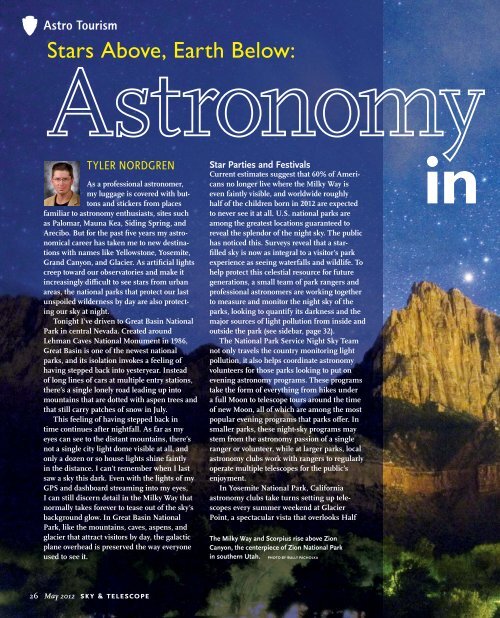Download this ebook as PDF - E-Book Library
Download this ebook as PDF - E-Book Library
Download this ebook as PDF - E-Book Library
You also want an ePaper? Increase the reach of your titles
YUMPU automatically turns print PDFs into web optimized ePapers that Google loves.
Astro Tourism<br />
Stars Above, Earth Below:<br />
Astronomy<br />
TYLER NORDGREN<br />
As a professional <strong>as</strong>tronomer,<br />
my luggage is covered with buttons<br />
and stickers from places<br />
familiar to <strong>as</strong>tronomy enthusi<strong>as</strong>ts, sites such<br />
<strong>as</strong> Palomar, Mauna Kea, Siding Spring, and<br />
Arecibo. But for the p<strong>as</strong>t fi ve years my <strong>as</strong>tronomical<br />
career h<strong>as</strong> taken me to new destinations<br />
with names like Yellowstone, Yosemite,<br />
Grand Canyon, and Glacier. As artifi cial lights<br />
creep toward our observatories and make it<br />
incre<strong>as</strong>ingly diffi cult to see stars from urban<br />
are<strong>as</strong>, the national parks that protect our l<strong>as</strong>t<br />
unspoiled wilderness by day are also protecting<br />
our sky at night.<br />
Tonight I’ve driven to Great B<strong>as</strong>in National<br />
Park in central Nevada. Created around<br />
Lehman Caves National Monument in 1986,<br />
Great B<strong>as</strong>in is one of the newest national<br />
parks, and its isolation invokes a feeling of<br />
having stepped back into yesteryear. Instead<br />
of long lines of cars at multiple entry stations,<br />
there’s a single lonely road leading up into<br />
mountains that are dotted with <strong>as</strong>pen trees and<br />
that still carry patches of snow in July.<br />
This feeling of having stepped back in<br />
time continues after nightfall. As far <strong>as</strong> my<br />
eyes can see to the distant mountains, there’s<br />
not a single city light dome visible at all, and<br />
only a dozen or so house lights shine faintly<br />
in the distance. I can’t remember when I l<strong>as</strong>t<br />
saw a sky <strong>this</strong> dark. Even with the lights of my<br />
GPS and d<strong>as</strong>hboard streaming into my eyes,<br />
I can still discern detail in the Milky Way that<br />
normally takes forever to te<strong>as</strong>e out of the sky’s<br />
background glow. In Great B<strong>as</strong>in National<br />
Park, like the mountains, caves, <strong>as</strong>pens, and<br />
glacier that attract visitors by day, the galactic<br />
plane overhead is preserved the way everyone<br />
used to see it.<br />
26 May 2012 sky & telescope<br />
Star Parties and Festivals<br />
Current estimates suggest that 60% of Americans<br />
no longer live where the Milky Way is<br />
even faintly visible, and worldwide roughly<br />
half of the children born in 2012 are expected<br />
to never see it at all. U.S. national parks are<br />
among the greatest locations guaranteed to<br />
reveal the splendor of the night sky. The public<br />
h<strong>as</strong> noticed <strong>this</strong>. Surveys reveal that a starfi<br />
lled sky is now <strong>as</strong> integral to a visitor’s park<br />
experience <strong>as</strong> seeing waterfalls and wildlife. To<br />
help protect <strong>this</strong> celestial resource for future<br />
generations, a small team of park rangers and<br />
professional <strong>as</strong>tronomers are working together<br />
to me<strong>as</strong>ure and monitor the night sky of the<br />
parks, looking to quantify its darkness and the<br />
major sources of light pollution from inside and<br />
outside the park (see sidebar, page 32).<br />
The National Park Service Night Sky Team<br />
not only travels the country monitoring light<br />
pollution, it also helps coordinate <strong>as</strong>tronomy<br />
volunteers for those parks looking to put on<br />
evening <strong>as</strong>tronomy programs. These programs<br />
take the form of everything from hikes under<br />
a full Moon to telescope tours around the time<br />
of new Moon, all of which are among the most<br />
popular evening programs that parks off er. In<br />
smaller parks, these night-sky programs may<br />
stem from the <strong>as</strong>tronomy p<strong>as</strong>sion of a single<br />
ranger or volunteer, while at larger parks, local<br />
<strong>as</strong>tronomy clubs work with rangers to regularly<br />
operate multiple telescopes for the public’s<br />
enjoyment.<br />
In Yosemite National Park, California<br />
<strong>as</strong>tronomy clubs take turns setting up telescopes<br />
every summer weekend at Glacier<br />
Point, a spectacular vista that overlooks Half<br />
The Milky Way and Scorpius rise above Zion<br />
Canyon, the centerpiece of Zion National Park<br />
in southern Utah. PHOTO BY WALLY PACHOLKA<br />
in


